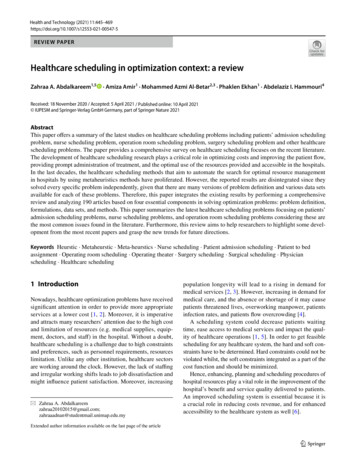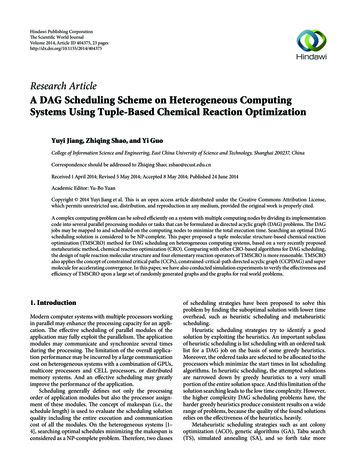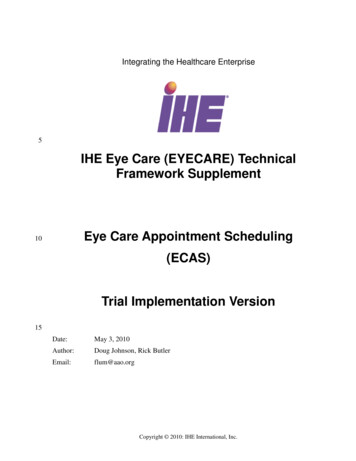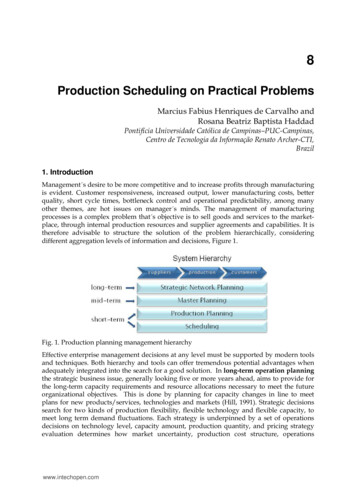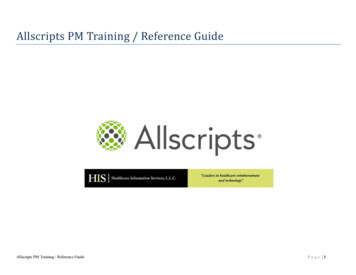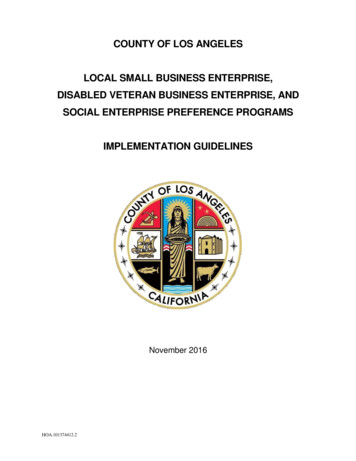
Transcription
Appointment Scheduling under Patient Preference andNo-Show BehaviorJacob FeldmanSchool of Operations Research and Information Engineering,Cornell University, Ithaca, NY 14853jbf232@cornell.eduNan LiuDepartment of Health Policy and Management, Mailman School of Public Health,Columbia University, New York, NY 10032nl2320@columbia.eduHuseyin TopalogluSchool of Operations Research and Information Engineering,Cornell University, Ithaca, NY 14853topaloglu@orie.cornell.eduSerhan ZiyaDepartment of Statistics and Operations Research,University of North Carolina, Chapel Hill, NC 27599ziya@unc.eduApril 9, 2014AbstractMotivated by the rising popularity of electronic appointment booking systems, we developappointment scheduling models that take into account the patient preferences regarding whenthey would like to be seen. The service provider dynamically decides which appointment daysto make available for the patients. Patients arriving with appointment requests may chooseone of the days offered to them or leave without an appointment. Patients with scheduledappointments may cancel or not show up for the service. The service provider collects a “revenue”from each patient who shows up and incurs a “service cost” that depends on the number ofscheduled appointments. The objective is to maximize the expected net “profit” per day. Webegin by developing a static model that does not consider the current state of the scheduledappointments. We give a characterization of the optimal policy under the static model and boundits optimality gap. Building on the static model, we develop a dynamic model that considers thecurrent state of the scheduled appointments and propose a heuristic solution procedure. In ourcomputational experiments, we test the performance of our models under the patient preferencesestimated through a discrete choice experiment that we conduct in a large community healthcenter. Our computational experiments reveal that the policies we propose perform well undera variety of conditions.
1IntroductionEnhancing patient experience of care has been set as one of the “triple aims” to improve thehealthcare system in many developed countries including the United States, Canada, and theUnited Kingdom. This aim is considered as equally, if not more, important as the other aims ofimproving the health of the population and managing per capita cost of care; see Berwick et al.(2008) and Institute for Healthcare Improvement (2012). An important component of enhancingpatient experience of care is to provide more flexibility to patients regarding how, when and where toreceive treatment. In pursuit of this objective, the National Health Service in the United Kingdomlaunched its electronic booking system, called Choose and Book, for outpatient appointments inJanuary 2006; see Green et al. (2008). In the United States, with the recent Electronic HealthRecords and Meaningful Use Initiative, which calls for more and better use of health informationtechnology, online scheduling is being adopted by an increasingly larger percentage of patients andclinics; see US Department of Health and Human Services (2011), Weiner et al. (2009), Silvestreet al. (2009), Wang and Gupta (2011)and Zocdoc (2012).In contrast to the traditional appointment scheduling systems where patients are more or lesstold by the clinic when to come and whom to see or are given limited options on the phone, electronicappointment booking practices make it possible to better accommodate patient preferences byproviding patients with more options. Giving patients more flexibility when scheduling theirappointments has benefits that can go beyond simply having more satisfied patients. More satisfiedpatients lead to higher patient retention rates, which potentially allow providers to negotiate betterreimbursement rates with payers; see Rau (2011). More satisfied patients can also lead to reducedno-show rates, helping maintain the continuity of care and improve patient health outcomes; seeBowser et al. (2010) and Schectman et al. (2008). An important issue when providing flexibility topatients is that of managing the operational challenges posed by giving more options. In particular,one needs to carefully choose the level of flexibility offered to the patients while taking into accountthe operational consequences. It is not difficult to imagine that giving patients complete flexibilityin choosing their appointment times would lead to high variability in the daily load of a clinic. Thus,options provided to the patients need to be restricted in a way that balances the benefits with thecosts. While such decisions have been studied in some industries, such as airlines, hospitalityand manufacturing, scheduling decisions with consideration of patient preferences has largely beenignored in the appointment scheduling literature; see Cayirli and Veral (2003), Gupta and Denton(2008) and Rohleder and Klassen (2000). The goal of this paper is to develop models that can aidin the appointment scheduling process while considering the patient preferences.In this paper, with electronic appointment booking systems in mind, we develop models, whichcan be used to decide which appointment days to offer in response to incoming appointmentrequests. Specifically, we consider a single service provider receiving appointment requests everyday. The service provider offers a menu of appointment dates within the scheduling windowfor patients to choose from. During the day, patients arrive with the intention of scheduling2
appointments and they either choose to book an appointment on one of the days made availableto them or leave without scheduling any. We assume that patient choice behavior is governed by amultinomial logit choice model; see McFadden (1974). In the meantime, patients with appointmentsmay decide not to show up and those with appointments on a future day may cancel. The serviceprovider generates a “revenue” from each patient who shows up for her appointment and incursa “cost” that depends on the number of patients scheduled to be seen on a day. The objective isto maximize the expected net “profit” per day by choosing the offer set, the set of days offered topatients who demand appointments. We begin by developing a static model, which can be usedto make decisions without using the information about the currently booked appointments. Then,we build on the static model and develop a dynamic formulation, which can be used to take thecurrent state of the booked appointments into consideration when making scheduling decisions.Our static model is a mathematical program in which the decision variables are the probabilitieswith which different subsets of appointment days will be offered to the patients, independent ofthe state of the booked appointments. One difficulty with this optimization problem is that thenumber of decision variables increases exponentially with the length of the scheduling window. Toovercome this, we exploit the special structure of the multinomial logit model to reformulate thestatic model in a more compact form. The number of decision variables in the compact formulationincreases only linearly with the number of days in the scheduling window, making it tractable tosolve. We show that if the no-show probability, conditional on the event that the patient has notcanceled before her appointment, does not depend on patient appointment delays, then there existsan easily implementable optimal policy from the static model, which randomizes between only twoadjacent offer sets. To assess the potential performance loss as a result of the static nature of themodel, we provide a bound on the optimality gap of the static model. The bound on the optimalitygap approaches zero as the average patient load per day increases, indicating that the static modelmay work well in systems handling high patient demand with respect to their capacity. In additionto randomized scheduling policies, we discuss how our approach can also be used to calculate theoptimal deterministic policy, which may be even easier to implement.Our dynamic model improves on the static one by taking the state of the booked appointmentsinto consideration when making its decisions. The starting point for the dynamic model is theMarkov decision process formulation of the appointment scheduling operations. Unfortunately,solving this formulation to optimality using standard dynamic programming tools is not practicalsince the state space is too large for realistically sized instances. Therefore, we propose anapproximation method based on the Markov decision process formulation. This approximationmethod can be seen as applying a single step of the standard policy improvement algorithm on aninitial “good” policy. For the initial “good” policy, we employ the policy provided by the staticmodel. Implementing the policy provided by the dynamic model allows us to make decisions inan online fashion by solving a mathematical program that uses the current state of the bookedappointments. The structure of this mathematical program is similar to the one we solve for thestatic model. Thus, the structural results obtained for the static model, at least partially, apply3
to the dynamic model as well. We carry out a simulation study to investigate how our proposedmethods perform. In order to create a clinic environment that is as realistic as possible, we estimatepatient preferences using data from a discrete choice experiment conducted in a large communityhealth center. We also generate numerous problem instances by varying model parameters sothat we can compare the performance of our policies with benchmarks over a large set of possiblesettings regarding the clinic capacity and the patient demand. These benchmarks are carefullychosen to mimic the policies used in practice. Our simulation study suggests that our proposeddynamic policy outperforms benchmarks, in particular when capacity is tight compared to demandand overtime cost is high.The studies in Ryan and Farrar (2000), Rubin et al. (2006), Cheraghi-Sohi et al. (2008), Gerardet al. (2008) and Hole (2008) all point out that patients do have preferences regarding when tovisit the clinic and which physician to see. In general, patients prefer appointments that are soonerthan later, but they may prefer a later day over an earlier one if the appointment on the later dayis at a more convenient time; see Sampson et al. (2008). Capturing these preferences in their fullcomplexity while keeping the formulation sufficiently simple can be a challenging task, but our staticand dynamic models yield tractable policies to implement in practice. The models we propose canbe particularly useful for clinics that are interested in a somewhat flexible implementation of openaccess, the policy of seeing today’s patient today; see Murray and Tantau (2000). While same-dayscheduling reduces the access time for patients and keeps no-show rates low, it is a feasible practiceonly if demand and service capacity are in balance; see Green and Savin (2008). Furthermore, somepatients highly value the flexibility of scheduling appointments for future days. A recent studyin Sampson et al. (2008) found that a 10% increase in the proportion of same-day appointmentswas associated with an 8% reduction in the proportion of patients satisfied. This is a somewhatsurprising finding, attributed to the decreased flexibility in booking appointments that comes withrestricting access to same-day appointments. Our models help find the “right” balance amongcompeting objectives of providing more choices to patients, reducing appointment delays, increasingsystem efficiency, and reducing no-shows.While past studies have found that patients have preferences regarding when they would like tobe seen, to our knowledge, there has been limited attempt in quantifying the relative preferences ofpatients using actual data. To understand patient preferences in practice and to use this insight inpopulating the model parameters in our computational study, we collected data from a large urbanhealth center in New York City and used these data to estimate the parameters of the patient choicemodel. For the patients of this particular clinic, the choice model estimates how patients chooseone day over the other. The choice model confirms that when patients have a health condition thatdoes not require an emergency but still needs fast attention, they do prefer to be seen earlier, evenafter taking their work and other social obligations into account.In addition to capturing the preferences of the patients on when they would like to be seen, apotentially useful feature of our models is that they capture the patient no-show process in a quite4
general fashion. In particular, the probability that a customer cancels her appointment on a givenday depends on when the appointment was scheduled and how many days there are left until theappointment day arrives. In this way, we can model the dependence of cancellation probabilities onappointment delays. Similarly, we allow the probability that a patient shows up for her appointmentto depend on how much in advance the appointment was booked. Past studies are split on howcancellation and no-show probabilities depend on appointment delays. A number of articles findthat patients with longer appointment delays are more likely to not show up for their appointments;see Grunebaum et al. (1996), Gallucci et al. (2005), Dreiher et al. (2008), Bean and Talaga (1995)and Liu et al. (2010). However, other studies found no such relationship; see Wang and Gupta(2011) and Gupta and Wang (2011). In this paper, we keep our formulation general so that no-showand cancellation probabilities can possibly depend on the delays experienced by patients.The rest of the paper is organized as follows. Section 2 reviews the relevant literature. Section 3describes the model primitives we use. Section 4 presents our static model, gives structural resultsregarding the policy provided by this model, provides a bound on the optimality gap, and derivessolutions for the optimal deterministic policies. Section 5 develops our dynamic model. Section 6discusses our discrete choice experiment on patient preferences, explains our simulation setup andpresents our numerical findings. Section 7 provides concluding remarks. In the Online Appendix,we discuss a number of extensions that can accommodate more general patient choice models, andpresent the proof of of the results that are omitted in the paper.2Literature ReviewThe appointment scheduling literature has been growing rapidly in recent years. Cayirli and Veral(2003) and Gupta and Denton (2008) provide a broad and coherent overview of this literature.Most work in this area focuses on intra-day scheduling and is typically concerned with timingand sequencing patients with the objective of finding the “right” balance between in-clinic patientwaiting times and physician utilization. In contrast, our work focuses on inter-day scheduling anddoes not explicitly address how intra-day scheduling needs to be done. In that regard, our modelscan be viewed as daily capacity management models for a medical facility. Similar to our work,Gerchak et al. (1996), Patrick et al. (2008), Liu et al. (2010), Ayvaz and Huh (2010) and Huh et al.(2013) deal with the allocation and management of daily service capacity. However, none of thesearticles take patient preferences and choice behavior into account.To our knowledge, Rohleder and Klassen (2000), Gupta and Wang (2008) and Wang and Gupta(2011) are the only three articles that consider patient preferences in the context of appointmentscheduling. These three articles deal with appointment scheduling within a single day, whereas ourwork focuses on decisions over multiple days. By focusing on a single day, Rohleder and Klassen(2000), Gupta and Wang (2008) and Wang and Gupta (2011) develop policies regarding the specifictiming of the appointments, but they do not incorporate the fact that the appointment preferences5
of patients may not be restricted within a single day. Furthermore, their proposed policies donot smooth out the daily load of the clinic. In contrast, since our policies capture preferences ofpatients over a number of days into the future, they can improve the efficiency in the use of theclinic’s service capacity by distributing demand over multiple days. Another interesting point ofdeparture between our work and the previous literature is the assumptions regarding how patientsinteract with the clinic while scheduling their appointments. Specifically, Gupta and Wang (2008)and Wang and Gupta (2011) assume that patients first reveal a set of their preferred appointmentslots to the clinic, which then decides whether to offer the patient an appointment in the set or toreject the patient. In our model, the clinic offers a set of appointment dates to the patients andthe patients either choose one of the offered days or decline to make an appointment.While there is limited work on customer choice behavior in healthcare appointment scheduling,there are numerous related papers in the broader operations literature, particularly in revenuemanagement and assortment planning. Typically, these papers deal with problems where a firmchooses a set of products to offer its customers based on inventory levels and remaining time inthe selling horizon. In response to the offered set of products, customers make a choice withinthe offered set according to a certain choice model. Talluri and van Ryzin (2004) consider arevenue management model on a single flight leg, where customers make a choice among the fareclasses made available to them. Gallego et al. (2004), Liu and van Ryzin (2008), Kunnumkal andTopaloglu (2008) and Zhang and Adelman (2009) extend this model to a flight network. Bront et al.(2009) and Rusmevichientong et al. (2010) study product offer decisions when there are multiplecustomer types, each type choosing according to a multinomial logit model with a different setof parameters. The authors show that the corresponding optimization problem is NP-hard. Incontrast, Gallego et al. (2011) show that the product offer decisions under the multinomial logitmodel can be formulated as a linear program when there is a single customer type. We refer thereader to Talluri and van Ryzin (2004) and Kök et al. (2009) for detailed overview of the literatureon revenue management and product offer decisions.Two papers that are particularly relevant to ours are Liu et al. (2010) and Topaloglu (2013). Liuet al. (2010) consider an appointment scheduling problem. Their model keeps track of appointmentsover a number of days and uses the idea of applying a single step of the policy improvementalgorithm to develop a heuristic method. Liu et al. (2010) do not take patient preferences intoaccount in any way and assume that patients always accept the appointment day offered tothem. This assumption makes the formulation and analysis in Liu et al. (2010) significantly simplerthan ours. Furthermore, we are able to characterize the structure of the optimal state-independentpolicy and provide a bound on the optimality gap of this policy, whereas Liu et al. (2010) doneither. On the other hand, Topaloglu (2013) considers a joint stocking and product offer modelover a single period. The model in Topaloglu (2013) is essentially a newsvendor model with multipleproducts, where the decision variables are the set of offered products and their correspondingstocking quantities. Customers choose among the set of offered products according to a certainchoice model and the objective is to maximize the total expected profit. This model is a single6
period model with newsvendor features. In contrast, we take on a dynamic appointment schedulingproblem, where patients arrive randomly over time and we need to adjust the set of offer days overtime as a function of the state of the system. Furthermore, our model has to explicitly deal withcancellations and no-shows. This dimension results in a high-dimensional state vector in a dynamicprogramming formulation and we need to come up with tractable approximate policies. Such anissue does not occur at all in a newsvendor setting.3Model PrimitivesWe consider a single care provider who schedules patient appointments over time and assume thatthe following sequence of events occur on each day.1 First, we observe the state of the appointmentsthat were already scheduled and decide which subset of days in the future to make available for thepatients making appointment requests on the current day. Second, patients arrive with appointmentrequests and choose an appointment day among the days that are made available to them. Third,some of the patients with appointments scheduled for future days may cancel their appointmentsand we observe the cancellations. Also, some of the patients with appointments scheduled on thecurrent day may not show up and we observe those who do. In reality, appointment requests,cancellations and show-ups occur throughout the day with no particular time ordering amongthem. Thus, it is important to note that our assumption regarding the sequence of events is simplya modeling choice and our policies continue to work as long as the set of days made available forappointments are chosen at the beginning of each day. The expected revenue the clinic generateson a day is determined by the number of patients that it serves on that day. The expected cost theclinic incurs is determined by the number of appointments scheduled for that day before no-showrealizations. This is mainly because staffing is the primary cost driver and staffing decisions haveto be made beforehand.The number of appointment requests on each day has Poisson distribution with mean λ. Eachpatient calling in for an appointment can potentially be scheduled either for the current day orfor one of the τ future days. Therefore, the scheduling horizon is T {0, 1, . . . , τ }, where day 0corresponds to the current day and the other days correspond to a day in the future. The decisionwe make on each day is the subset of days in the scheduling horizon that we make available forappointments. If we make the subset S T of days available for appointments, then a patientschedules an appointment j days into the future with probability Pj (S). We assume that the choiceprobability Pj (S) is governed by the multinomial logit choice model; see McFadden (1974). Underthis choice model, each patient associates the preference weight of vj with the option of schedulingan appointment j days into the future. Furthermore, each patient associates the nominal preferenceweight of 1 with the option of not scheduling an appointment at all. In this case, if we offer the1Some physicians work as a member of a physician team and reserves a certain number of appointment slots ineach day for urgent patients (e.g., walk-ins) who can be seen by any one of the team members, but use the rest oftheir service capacity for scheduling their own patients only. In such a team practice, our focus is on managing thecapacity that is reserved for scheduled appointments only.7
subset S of days available for appointments, then the probability that an incoming patient schedulesan appointment j S days into the future is given byPj (S) With the remaining probability, N (S) 1 system without scheduling an appointment.1 PvPjj Sk Svk.Pj (S) 1/(1 (1)Pk Svk ), a patient leaves theIf a patient called in i days ago and scheduled an appointment j days into the future, then this0 , independently of the otherpatient cancels her appointment on the current day with probability rij0 is the probabilityappointments scheduled. For example, if the current day is October 15, then r13a patient who called in on October 14 and scheduled an appointment for October 17 cancels her0 so that r is the probability that we retain aappointment on the current day. We let rij 1 rijijpatient who called in i days ago and scheduled an appointment j days into the future. If a patientcalled in i days ago and scheduled an appointment on the current day, then this patient shows upfor her appointment with probability si , conditional on the event that she has not canceled untilthe current day. We assume that rij is decreasing in j for a fixed value of i so that the patientsscheduling appointments further into the future are less likely to be retained.For each patient served on a particular day, we generate a nominal revenue of 1. We have aregular capacity of serving C patients per day. After observing the cancellations, if the number ofappointments scheduled for the current day exceeds C, then we incur an additional staffing andovertime cost of θ per patient above the capacity. The cost of the regular capacity of C patients isassumed to be sunk and we do not explicitly account for this cost in our model. With this setup,the profit per day is linear in the number of patients that show up and piecewise-linear and concavein the number of appointments that we retain for the current day, but our results are not tied tothe structure of this cost function and it is straightforward to extend our development to cover thecase where the profit per day is a general concave function of the number of patients that showup and the number of appointments that we retain. Using such a general cost structure, one caneasily enforce a capacity limit beyond which no patients can be scheduled by setting the cost ratebeyond this capacity limit sufficiently high. Note that we also choose not to incorporate any costassociated with the patients’ appointment delay mainly because in our model patients choose theirappointment day based on their preferences anyway. Still, it is important to note that one can infact incorporate such costs into our formulation rather easily since our formulation already keepstrack of the appointment delay each patient experiences.We can formulate the problem as a dynamic program by using the status of the appointments atthe beginning of a day as the state variable. Given that we are at the beginning of day t, we can letYij (t) be the number of patients that called in i days ago (on day t i), scheduled an appointmentj days into the future (for day t i j) and are retained without cancellation until the currentday t. In this case, the vector Y (t) {Yij (t) : 1 i j τ } describes the state of the scheduledappointments at the beginning of day t. This state description has τ (τ 1)/2 dimensions and the8
state space can be very large even if we bound the number of scheduled appointments on a day bya finite number. In the next section, we develop a static model that makes its decisions withoutconsidering the current state of the booked appointments. Later on, we build on the static modelto construct a dynamic model that indeed considers the state of the booked appointments.4Static ModelIn this section, we consider a static model that makes each subset of days in the scheduling horizonavailable for appointments with a fixed probability. Since the probability of offering a particularsubset of days is fixed, this model does not account for the current state of appointments whenmaking its decisions. We solve a mathematical program to find the best probability with whicheach subset of days should be made available.To formulate the static model, we let h(S) be the probability with which we make the subsetS T of days available. If we make the subset S of days available with probability h(S),then the probability that a patient schedules an appointment j days into the future is given byPS T Pj (S) h(S). Given that a patient schedules an appointment j days into the future, weretain this patient until the day of the appointment with probability r̄j r0j r1j . . . rjj . Similarly,this patient shows up for her appointment with probability s̄j r0j r1j . . . rjj sj . Thus, notingthat the number of appointment requests on a day has Poisson distribution with parameter λ, ifwe make the subset S of days available with probability h(S), then the number of patients thatschedule an appointment j days into future and that are retained until the day of the appointmentPis given by a Poisson random variable with mean λ r̄j S T Pj (S) h(S). Similarly, we can use aPPoisson random variable with mean λ s̄j S T Pj (S) h(S) to capture the number of patients thatschedule an appointment j days into the future and that show up for their appointments. Inthis case, using Pois(α) to denote a Poisson random variable with mean α, on each day, thetotal number of patients whose appointments we retain until the day of the appointment is given PPby Poisj TS T λ r̄j Pj (S) h(S) and the total number of patients that show up for their PPappointments is given by Poisj TS T λ s̄j Pj (S) h(S) . To find the subset offer probabilitiesthat maximize the expected profit per day, we can solve the problemnh X X i oXXmaxλ s̄j Pj (S) h(S) θ E Poisλ r̄j Pj (S) h(S) C(2)j T S Tsubject toXj T S Th(S) 1(3)S Th(S) 0S T,(4)where we use [·] max{·, 0}. In the problem above, the two terms in the objective functioncorrespond to the expected revenue and the expected cost per day. The constraint ensures thatthe total probability with which we offer a subset of days is equal to 1. Noting T , the problemabove allows not offering any appointment slots to an arriving patient.9
4.1ReformulationProblem (2)-(4) has 2 T decision variables, which can be too many in practical applications. Forexample, if we have a scheduling horizon of a month, then the number of decision variables in thisproblem exceeds a billion. However, it turns out that we can give an equivalent formulation forproblem (2)-(4) that has only T 1 decision variables, which makes this problem quite tractable. Inparticular, Proposition 1 below shows that problem (2)-(4) is equivalent to the problemmaxXnh X i oλ s̄j xj θ E Poisλ r̄j xj Cj Tsubje
appointment scheduling models that take into account the patient preferences regarding when they would like to be seen. The service provider dynamically decides which appointment days to make available for the patients. Patients arriving with appointment requests may choose one of the days o ered to them or leave without an appointment.
